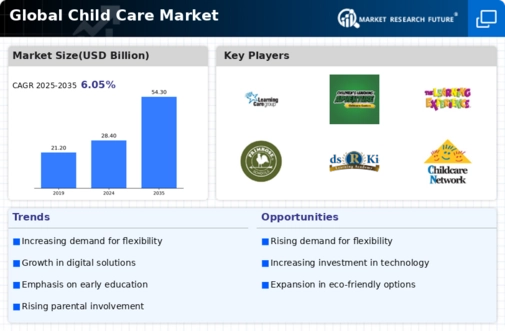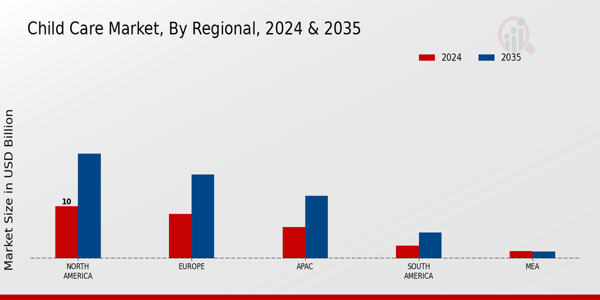Market Trends
Key Emerging Trends in the Child Care Market
The way that modern families are changing has led to an increasing reliance on outside child care providers. When both parents work, it is frequently necessary to hire professional child care services to fill in the gaps in the caregiving responsibilities. Child care centers offer working parents a structured, monitored environment that promotes the education and development of young children. Due to the rise in dual-income families, parents are becoming more willing to pay for child care services. As disposable incomes improve, families may afford to spend money on upscale daycare facilities that offer distinctive programs and activities for children. The need to invest in child care contributes to the market's growth.
The child care market is experiencing notable trends shaped by evolving societal needs, parental preferences, and advancements in early childhood education. One significant trend is the increasing demand for high-quality and educational child care services. Parents today are placing a greater emphasis on early childhood development, recognizing the importance of a stimulating and educational environment for their children. This has led to a rise in the popularity of child care facilities that integrate structured learning activities, interactive play, and age-appropriate curriculum into their programs, catering to parents seeking comprehensive educational experiences for their youngsters.
Additionally, flexibility in child care arrangements is becoming a key trend. With the changing dynamics of work and family life, parents are seeking child care solutions that offer flexibility in terms of hours, locations, and scheduling. This trend is driving the growth of options such as drop-in child care services, extended hours, and part-time enrollment in traditional child care centers. The market is adapting to meet the diverse needs of modern families, providing parents with more choices to align child care arrangements with their work and lifestyle demands.
Furthermore, the integration of technology in child care services is gaining momentum. Parents are increasingly comfortable with the idea of technology playing a role in their children's early education, and child care providers are incorporating digital tools to enhance learning experiences. This includes the use of educational apps, interactive devices, and online communication platforms to keep parents informed about their child's activities and developmental progress. The adoption of technology in child care not only meets the expectations of tech-savvy parents but also prepares children for the digital age.
In response to the ongoing global health concerns, health and safety have become paramount in the child care market. Parents are prioritizing child care facilities that uphold rigorous health and safety standards, including proper hygiene practices, sanitation measures, and illness prevention protocols. Child care providers are investing in enhanced cleaning procedures, health screenings, and contingency plans to address the concerns of parents who are placing a heightened focus on the well-being of their children in group care settings.
Moreover, there is a growing trend towards eco-friendly and sustainable practices in the child care market. Parents are becoming more environmentally conscious, and this awareness extends to the choices they make for their children. Child care facilities are responding by adopting sustainable practices such as using eco-friendly materials, reducing waste, and incorporating nature-based learning elements. This trend reflects a broader societal shift towards environmentally responsible practices and a desire to instill these values in children from a young age.










Leave a Comment